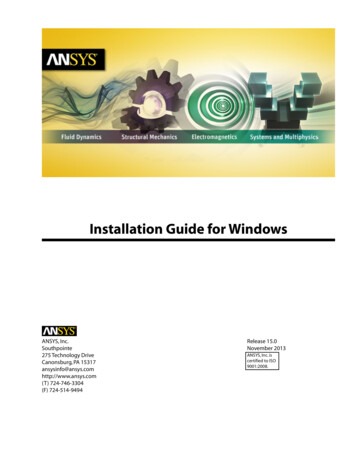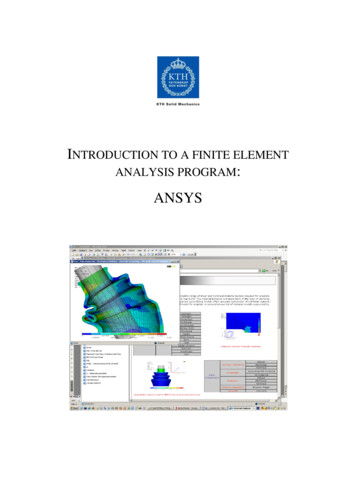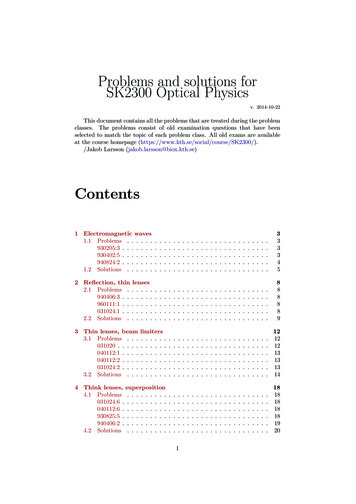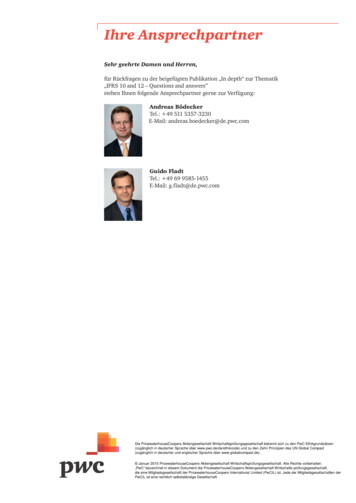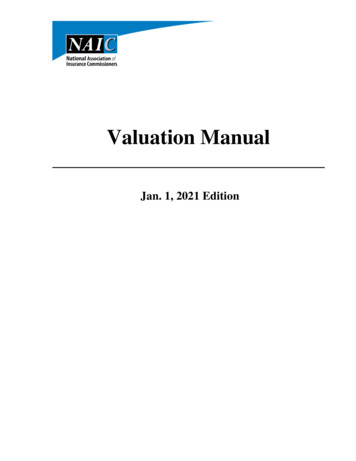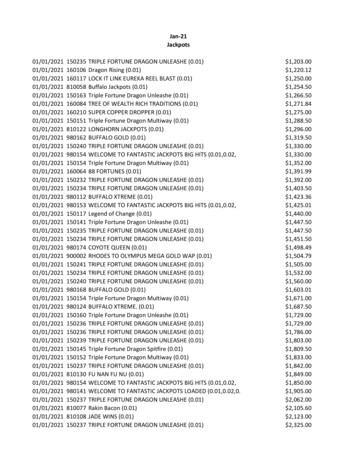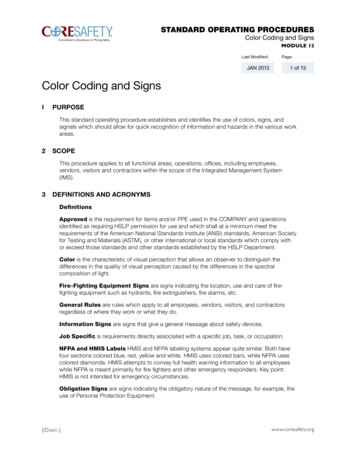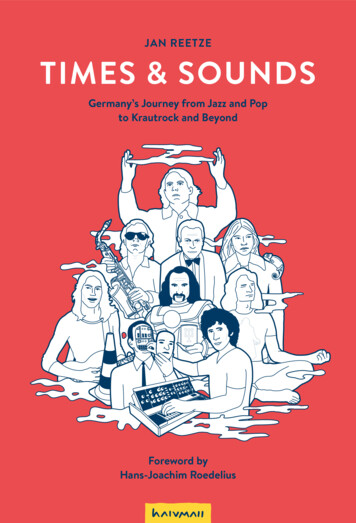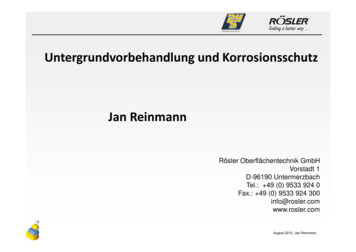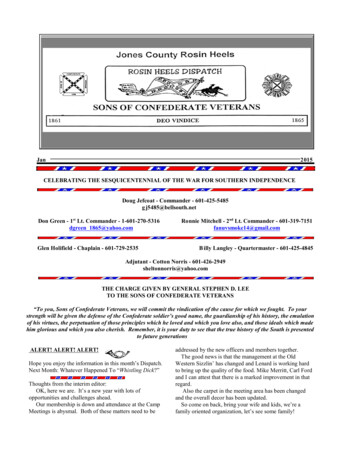
Transcription
Time series analysisJan Grandell
2
PrefaceThe course Time series analysis is based on the book [7] and replaces ourprevious course Stationary stochastic processes which was based on [6]. Thebooks, and by that the courses, differ in many respects, the most obvious isthat [7] is more applied that [6]. The word “applied” is partly a fine wordfor “elementary”. A very important part of the course consists in lookingat and thinking through the examples in [7] and to play around with theenclosed computer package ITSM or with Matlab. Jan Enger has constructeda number of M-files in order to facilitate use of Matlab within this course.Those who want to use Matlab later in connection with time series can use thetoolbox System Identification by Lennart Ljung, which contains an extensivelibrary of stochastic models related to time series and control theory.The main reason for the change in the courses is that half of our intermediate course Probability theory treats stationary processes from a theoreticalpoint of view. A second reason is that a course in time series analysis is usefulalso for students more interested in applications than in the underlying theory.There are many references to [6] in [7] and the best recommendation to give astudent interested in the subject also from a more theoretical point of view isto buy both books. However, due to the price of books, this recommendationmight be unrealistic. A “cheaper” recommendation to those students is to readthis lecture notes, where many parts from our previous course, i.e. in realityfrom [6], are included. These parts are given in the Appendix and in insertedparagraphs. The inserted paragraphs are written in this style.I am most grateful for all kind of criticism, from serious mathematicalmistakes to trivial misprints and language errors.Jan Grandelli
iiPREFACE
ContentsPrefaceiLecture 11.1 Introduction . . . . . . . . . . . .1.2 Stationarity . . . . . . . . . . . .1.3 Trends and Seasonal Components1.3.1 No Seasonal Component .1.3.2 Trend and Seasonality . .112346.Lecture 22.1 The autocovariance of a stationary time series2.1.1 Strict stationarity . . . . . . . . . . . .2.1.2 The spectral density . . . . . . . . . .2.2 Time series models . . . . . . . . . . . . . . .9. 9. 11. 11. 12.19191921222325Lecture 44.1 Prediction . . . . . . . . . . . . . . . . . . . . . . . . . . . . . .4.1.1 Prediction of random variables . . . . . . . . . . . . . . .4.1.2 Prediction for stationary time series . . . . . . . . . . . .29292932Lecture 55.1 The Wold decomposition . . . . . . . .5.2 Partial correlation . . . . . . . . . . . .5.2.1 Partial autocorrelation . . . . .5.3 ARMA processes . . . . . . . . . . . .5.3.1 Calculation of the ACVF . . . .5.3.2 Prediction of an ARMA Process39394041414244Lecture 33.1 Estimation of the mean and the autocovariance3.1.1 Estimation of µ . . . . . . . . . . . . . .3.1.2 Estimation of γ(·) and ρ(·) . . . . . . . .3.2 Prediction . . . . . . . . . . . . . . . . . . . . .3.2.1 A short course in inference . . . . . . . .3.2.2 Prediction of random variables . . . . . .iii.
ivCONTENTSLecture 66.1 Spectral analysis . . . . . . . . . . . . . . . .6.1.1 The spectral distribution . . . . . . . .6.1.2 Spectral representation of a time series6.2 Prediction in the frequency domain . . . . . .6.2.1 Interpolation and detection . . . . . .6.3 The Itô integral . . . . . . . . . . . . . . . . .Lecture 77.1 Estimation of the spectral density .7.1.1 The periodogram . . . . . .7.1.2 Smoothing the periodogram7.2 Linear filters . . . . . . . . . . . . .7.2.1 ARMA processes . . . . . .Lecture 88.1 Estimation for ARMA models . . . . . . . . .8.1.1 Yule-Walker estimation . . . . . . . . .8.1.2 Burg’s algorithm . . . . . . . . . . . .8.1.3 The innovations algorithm . . . . . . .8.1.4 The Hannan–Rissanen algorithm . . .8.1.5 Maximum Likelihood and Least Square8.1.6 Order selection . . . . . . . . . . . . . . . . . . . . . . . . . . . . . . . . . . . . . . . . . . .estimation . . . . . . re 9899.1 Unit roots . . . . . . . . . . . . . . . . . . . . . . . . . . . . . . 899.2 Multivariate time series . . . . . . . . . . . . . . . . . . . . . . . 91Lecture 1010.1 Financial time series . . . . . . . . . . . . . . .10.1.1 ARCH processes . . . . . . . . . . . . .10.1.2 GARCH processes . . . . . . . . . . . .10.1.3 Further extensions of the ARCH process10.1.4 Literature about financial time series . .Lecture 1111.1 Kalman filtering . . . . . . . . . . . . . .11.1.1 State-Space representations . . .11.1.2 Prediction of multivariate random11.1.3 The Kalman recursions . . . . . . . . . . . . . . . .variables. . . . . .9595969899101.103. 103. 103. 105. 107Appendix111A.1 Stochastic processes . . . . . . . . . . . . . . . . . . . . . . . . . 111A.2 Hilbert spaces . . . . . . . . . . . . . . . . . . . . . . . . . . . . 115References119
CONTENTSIndexv120
viCONTENTS
Lecture 11.1IntroductionA time series is a set of observations xt , each one being recorded at a specifictime t.Definition 1.1 A time series model for the observed data {xt } is a specification of the joint distributions (or possibly only the means and covariances)of a sequence of random variables {Xt } of which {xt } is postulated to be arealization.In reality we can only observe the time series at a finite number of times,and in that case the underlying sequence of random variables (X1 , X2 , . . . , Xn )is just a an n-dimensional random variable (or random vector). Often, however,it is convenient to allow the number of observations to be infinite. In that case{Xt , t 1, 2, . . .} is called a stochastic process. In order to specify its statisticalproperties we then need to consider all n-dimensional distributionsP [X1 x1 , . . . , Xn xn ] for all n 1, 2, . . . ,cf. Section A.1 on page 111 for details.Example 1.1 (A binary process) A very simple example of a stochasticprocess is the binary process {Xt , t 1, 2, . . . } of independent random variables with1P (Xt 1) P (Xt 1) .2In this case we haveP (X1 i1 , X2 i2 , . . . , Xn in ) 2 nwhere ik 1 or 1. In Example A.2 on page 113 it is shown that the binaryprocess is “well-defined”.2Definition 1.2 (IID noise) A process {Xt , t Z} is said to be an IID noisewith mean 0 and variance σ 2 , written{Xt } IID(0, σ 2 ),if the random variables Xt are independent and identically distributed withEXt 0 and Var(Xt ) σ 2 .1
2LECTURE 1The binary process is obviously an IID(0, 1)-noise.In most situations to be considered in this course, we will not need the“full” specification of the underlying stochastic process. The methods willgenerally rely only on its means and covariances and – sometimes – on somemore or less general assumptions.Consider a stochastic process {Xt , t T }, where T is called the index orparameter set. Important examples of index sets areZ {0, 1, 2, . . . }, {0, 1, 2, . . . }, ( , ) and [0, ).A stochastic process with T Z is often called a time series.Definition 1.3 Let {Xt , t T } be a stochastic process with Var(Xt ) .The mean function of {Xt } isdefµX (t) E(Xt ),t T.The covariance function of {Xt } isγX (r, s) Cov(Xr , Xs ),r, s T.Example 1.2 (Standard Brownian motion) A standard Brownian motion, or a standard Wiener process, {B(t), t 0} is a stochastic process with B(0) 0, independentincrements, and B(t) B(s) N (0, t s) for t s, see Definition A.5 on page 114 for details. The notation N (0, t s) means, contrary to the notation used in [1], that the varianceis t s. We have, for r sγB (r, s) Cov(B(r), B(s)) Cov(B(r), B(s) B(r) B(r)) Cov(B(r), B(s) B(r)) Cov(B(r), B(r)) 0 r rand thus, if nothing is said about the relation between r and sγB (r, s) min(r, s).21.2StationarityLoosely speaking, a stochastic process is stationary, if its statistical propertiesdo not change with time. Since, as mentioned, we will generally rely only onproperties defined by the means and covariances, we are led to the followingdefinition.Definition 1.4 The time series {Xt , t Z} is said to be (weakly) stationaryif(i) Var(Xt ) (ii) µX (t) µfor all t Z,for all t Z,(iii) γX (r, s) γX (r t, s t)for all r, s, t Z.
1.3. TRENDS AND SEASONAL COMPONENTS3(iii) implies that γX (r, s) is a function of r s, and it is convenient to definedefγX (h) γX (h, 0).The value “h” is referred to as the “lag”.Definition 1.5 Let {Xt , t Z} be a stationary time series. The autocovariance function (ACVF) of {Xt } isγX (h) Cov(Xt h , Xt ).The autocorrelation function (ACF) isdefρX (h) γX (h).γX (0)A simple example of a stationary process is the white noise, which may belooked a upon as the correspondence to the IID noise when only the meansand the covariances are taken into account.Definition 1.6 (White noise) A process {Xt , t Z} is said to be a whitenoise with mean µ and variance σ 2 , written{Xt } WN(µ, σ 2 ),(if EXt µ and γ(h) σ20if h 0,if h 6 0.Warning: In some literature white noise means IID.1.32Trends and Seasonal ComponentsConsider the “classical decomposition” modelXt mt st Yt ,wheremt is a slowly changing function (the “trend component”);st is a function with known period d (the “seasonal component”);Yt is a stationary time series.Our aim is to estimate and extract the deterministic components mt andst in hope that the residual component Yt will turn out to be a stationary timeseries.
41.3.1LECTURE 1No Seasonal ComponentAssume thatXt mt Yt ,t 1, . . . , nwhere, without loss of generality, EYt 0.Method 1 (Least Squares estimation of mt )If we assume that mt a0 a1 t a2 t2 we choose bak to minimizenX(xt a0 a1 t a2 t2 )2 .t 1Method 2 (Smoothing by means of a moving average)Let q be a non-negative integer and considerqX1Wt Xt j ,2q 1 j qThenq 1 t n q.qqXX11Wt mt j Yt j mt ,2q 1 j q2q 1 j qprovidedq is so small that mt is approximately linear over [t q, t q]andPq1q is so large that 2q 1j q Yt j 0.For t q and t n q some modification is necessary, e.g.mbt n tXα(1 α)j Xt jfor t 1, . . . , qj 0andmbt t 1Xα(1 α)j Xt jfor t n q 1, . . . , n.j 0The two requirements on q may be difficult to fulfill in the same time. Letus therefore consider a linear filterPmbt aj Xt j ,Pwhereaj 1 and aj a j . Such a filter will allow a linear trend to passwithout distortion sincePPPaj (a b(t j)) (a bt) aj b aj j (a bt) · 1 0.In the above example we have(aj 12q 10for j q,for j q.
1.3. TRENDS AND SEASONAL COMPONENTS5It is possible to choose the weights {aj } so that a larger class of trend functionspass without distortion. Such an example is the Spencer 15-point movingaverage where[a0 , a 1 , . . . , a 7 ] 1[74, 67, 46, 21, 3, 5, 6, 3] and aj 0 for j 7.320Applied to mt at3 bt2 ct d we getPPPmbt aj Xt j aj mt j aj Yt jP aj mt j see problem 1.12 in [7] mt .Method 3 (Differencing to generate stationarity)Define the difference operator by Xt Xt Xt 1 (1 B)Xt ,where B is the backward shift operator, i.e. (BX)t Xt 1 , and its powers k Xt ( k 1 X)t .As an example we get 2 Xt Xt Xt 1 (Xt Xt 1 ) (Xt 1 Xt 2 ) Xt 2Xt 1 Xt 2 .As an illustration of “the calculus of operators” we give a different “proof”: 2 Xt (1 B)2 Xt (1 2B B 2 )Xt Xt 2Xt 1 Xt 2 .If mt a bt we get Xt mt Yt a bt a b(t 1) Yt b YtandCov[ Yt , Ys ] Cov[Yt , Ys ] Cov[Yt 1 , Ys ] Cov[Yt , Ys 1 ] Cov[Yt 1 , Ys 1 ] γY (t s) γY (t s 1) γY (t s 1) γY (t s) 2γY (t s) γY (t s 1) γY (t s 1).Thus Xt is stationary.PGenerally, if mt kj 0 cj tj we get k Xt k!ck k Yt ,which is stationary, cf. problem 1.10 in [7].Thus is tempting to try to get stationarity by differencing. In practice oftenk 1 or 2 is enough.
6LECTURE 11.3.2Trend and SeasonalityLet us go back toXt mt st Yt ,P st and dk 1 sk 0. For simplicity we assume that n/dwhere EYt 0, st dis an integer.Typical values of d are: 24 for period: day and time-unit: hours; 7 for period: week and time-unit: days; 12 for period: year and time-unit: months.Sometimes it is convenient to index the data by period and time-unitxj,k xk d(j 1) ,nk 1, . . . , d, j 1, . . . , ,di.e. xj,k is the observation at the k:th time-unit of the j:th period.Method S1 (Small trends)It is natural to regard the trend as constant during each period, which meansthat we consider the modelXj,k mj sk Yj,k .Natural estimates ared1Xmbj xj,kd k 1n/ddXand sbk (xj,k mb j ).n j 1Method S2 (Moving average estimation)First we apply a moving average in order to eliminate the seasonal variationand to dampen the noise. For d even we use q d/2 and the estimatembt 0.5xt q xt q 1 · · · xt q 1 0.5xt qdand for d odd we use q (d 1)/2 and the estimatembt xt q xt q 1 · · · xt q 1 xt qdprovided q 1 t n q.In order to estimate sk we first form the “natural” estimateswk 1number of summandsXq k j n q kdd(xk jd mb k jd ).
1.3. TRENDS AND SEASONAL COMPONENTS7(Note that it is “only” the end-effects that force us to this formally complicatedestimate. What we really are doing is to take the average of those xk jd :s wherethe mk jd :s can be estimated.)PIn order to achieve dk 1 sbk 0 we form the estimatesdsbk wk 1Xwi ,d i 1k 1, . . . , d.Method S3 (Differencing at lag d)Define the lag-d dif
A time series is a set of observations xt, each one being recorded at a specific time t. Definition 1.1 A time series model for the observed data {xt} is a specifi-cation of the joint distributions (or possibly only the means and covariances) of a sequence of random variables {Xt} of which {xt} is postulated to be a realization. In reality we can only observe the time series at a finite .
